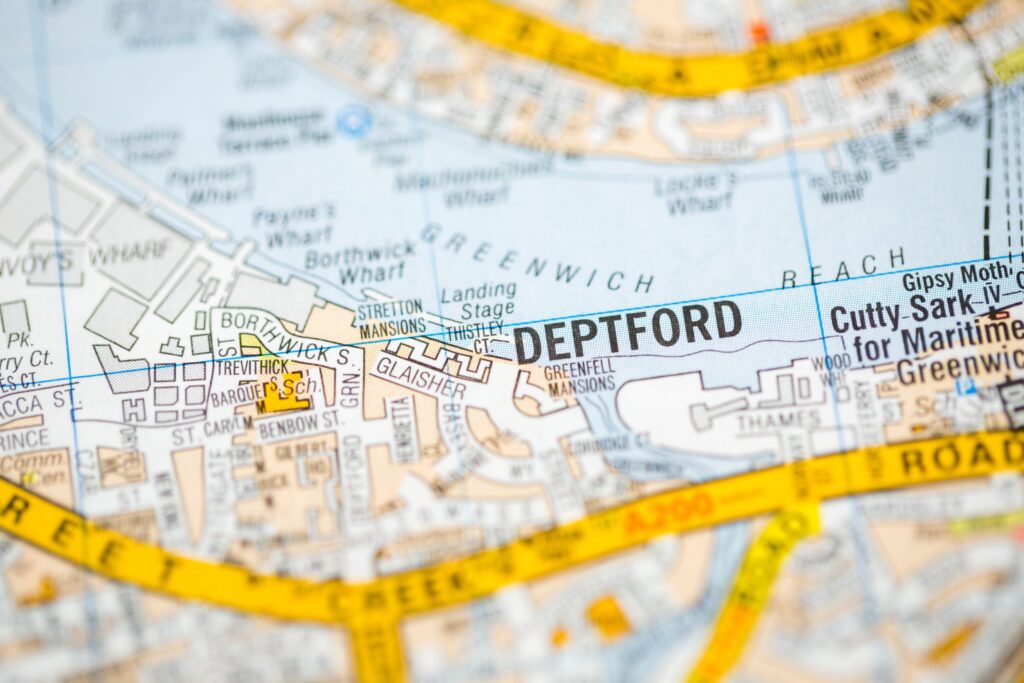
DEREK TURNER pays tribute to grittily resilient S.E.8
Aircraft always overhead, trains pulling in and out, traffic backed up along the New Cross Road, pulsating rap from open windows, plastic bottles in the gutter, pigeons with fungus-eaten toes, gang tags on gritty walls, smells of exhaust, fast food, sweat and the shower-gel of the highly made-up, high-heeled woman who just clicked by oblivious, while texting someone worth noticing somewhere worth noticing…
Drake, Blake, and Nelson look not down on us but rather out, over somewhere in the storied past before this unremarkable moment. A gilded galleon glints on the weathervane above them, a naval battle is taking place in the tympanum beneath their feet, and tritons uphold the front door.
Deptford’s Town Hall is a rare outpost of exuberance to find in an inner-suburban sea, a neo-baroque flourish built between 1903 and 1905 for the Metropolitan Borough of Deptford, with iconography reflecting the area’s long maritime history. It was never the most practical of buildings, but it has been increasingly inconvenient since the 1960s, when the Borough was eaten by the new Borough of Lewisham, which eventually sold it to Goldsmiths College. Today, its architecture is even more inconvenient – and the swaggering statues are worse than that, facing calls by ‘activists’ for their removal and erasure. They are too confident role-models for an era in English history that doesn’t much care for confidence – or even Englishness.
Drake could never have imagined such Angst-ridden arguments, as he waited aboard the Golden Hind alongside at Deptford on 4 April 1581, looking out for a very special visitor – Elizabeth I, come to honour his epic circumnavigation. Before evening, he would be Sir Francis, knighted aboard by the French Ambassador rather than the Queen, who however privately proud, could not be seen to endorse Drake’s more dubious activities. He was hitherto ensconced in an island nation’s mythology, an unmissable inclusion for the Town Hall architects seeking English ‘immortals’ to keep permanent watch above the New Cross Road. Blake could not have foreseen all this either, as he kept an anxious eye along the Thames corridor for the Dutch – and Nelson would certainly not have seen that signal.
The Golden Hind lay at Deptford (and stayed there until she fell to pieces) because Elizabeth’s father had established the King’s Yard – later, the Royal Naval Dockyard – there in 1513, on a convenient bend in the Thames, downstream from the crammed Pool of London, in the flatlands of the north Kent/Surrey borders. On 19 June 1549, the young Edward VI toured his father’s Yard, and was shown an after-supper spectacle, a mock-naval battle:
…a fort made upon a great lighter on the Thames … of which Mr. Winter was captain, with forty or fifty other soldiers … To the fort also appertained a galley … Wherefore there came 4 pinnaces … which … with clods, squibs, canes of fire, darts … and bombards, assaulted the castle; and at length … burst the outer walls of the castle, beating them of the castle into the second ward, who after issued out and drove away the pinnaces, sinking one of them, out of which all the men in it … leaped out, and swam in the Thames. Then came th’ admiral of the navy and three pinnaces, and won the castle by assault, and burst the top of it down, and took the captain…

Between 1513 and the Yard’s closure in 1869, hundreds of ships were built, fitted out or repaired at Deptford, making it an epicentre of English seapower on the edge of otherwise quiet countryside – a teeming townlet of hovels, smithies, stores, taverns and workshops, the headquarters of the navigational guild Trinity House, and grand houses of those who needed to be near to the Navy for reasons of duty or state. There were always secrets, troubles and valuables to be found at Deptford, locked up in statesmen’s offices or shipwrights’ desks, bonded in warehouses, guarded by marines, yarned about or perhaps passed over furtively in pubs, like the one in which Christopher Marlowe was stabbed to death by Francis Frezer in 1593, allegedly in a quarrel over the ‘recknynge’, although some think this was only a pretext, and the gay playwright was there on a secret mission for Elizabeth’s ‘spymaster,’ Sir Francis Walsingham. In 1993, we saw a tablet unveiled to him at St Nicholas Church, after a starry, strange dedication service during which Anthony Sher read from Tamburlaine the Great, Janet Suzman from Dido, Queen of Carthage, and Sam Wanamaker read Edward Blount’s 1598 reflections on his dead friend, while men dressed as nuns distributed leaflets about AIDS.

The Yard would remain a major strategic asset through the following century, when Blake knew the Yard, and after Restoration, Samuel Pepys and John Evelyn. Pepys came down here often on Admiralty business, busily commuting between here and his house in the City, his head full of practical reforms and quidnunc preoccupations. On 16 April 1661, for example, he diarized ‘Then we put off for Deptford, where we went aboard the Kings pleasure-boat that Commissioner Pett is making; and endeed it will be a most pretty thing.’
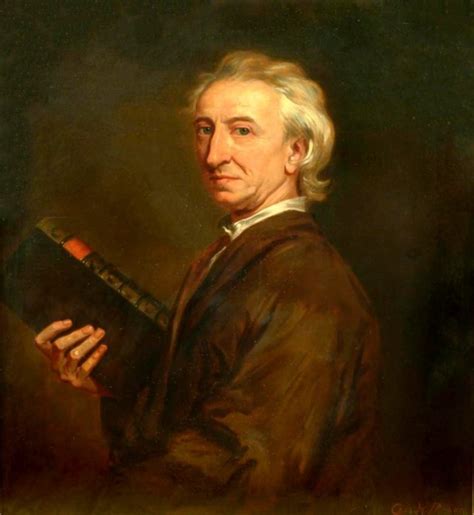
John Evelyn lived in Deptford for forty years, fertilely for local legend. In 1658, a 58 feet long whale was killed off Deptford Strand, and another almost as big in 1699. In 1671, Evelyn came upon a highly skilled woodcarver in ‘an obscure place’ in Deptford, and was so impressed he introduced him to Christopher Wren and Charles II. Grinling Gibbons would go on to adorn some of the greatest houses of England.
Evelyn’s house was Sayes Court – a rambling brick house with a famous 100-acre garden, an experimental station and pleasure-ground for the romantic but also scientifically-minded author of Sylva (1664), one of the first and most influential books about forestry. Evelyn was devoted to his garden, and wrote copious maintenance and management notes under the title of Directions for the Gardiner at Says-Court, But which may be of Use for Other Gardens. A 1652 plan shows an elegant arrangement of ‘faire gravel walkes,’ fountains, grassy ‘plotts’, ‘long pourmenades’, box-hedged ‘par=terres’, an orchard and an evergreen thicket ‘for Birds private walkes, shades and Cabinetts’ – a haven of ‘choice flowers, and Simples,’ French walnuts and much else.
In 1696, Evelyn leased the house to Admiral Benbow, but found him a careless tenant. Worse came in 1698, when Evelyn, ‘asked’ by William III, allowed Czar Peter the Great and his entourage to rent Sayes Court while Peter was staying in England to study the latest shipbuilding techniques, as part of the modernizing monarch’s opening of a ‘window to the West.’ The towering, twenty-something Czar (he was 6 feet 7 inches tall) was none too careful with other people’s possessions. Evelyn’s servant reported to his master while the Czar was in residence, ‘There is a house full of people, and right nasty.’ Peter and his retinue trashed the house and garden, amongst other damage burning the bedding, using paintings for target practice, and crashing through an ilex hedge in a go-kart, causing the diarist to grumble on 9 June 1698:
To Deptford, to see how miserably the Czar had left my house, after three months making it his Court. I got Sir Christopher Wren, the King’s surveyor, and Mr London his gardener, to go and estimate the repairs, for which they allowed £150 in their report to the Treasury.

Evelyn’s painfully repaired paradise has gone, although there is a park on part of the site, with a twisted old mulberry tree on metal crutches (sadly, not one of his). Part of the house survived somehow, latterly as a workhouse, until the 20th century, by which time Deptford had long lost the Dockyard and most of its greenery, and become synonymous with urban deprivation. But other things have survived.
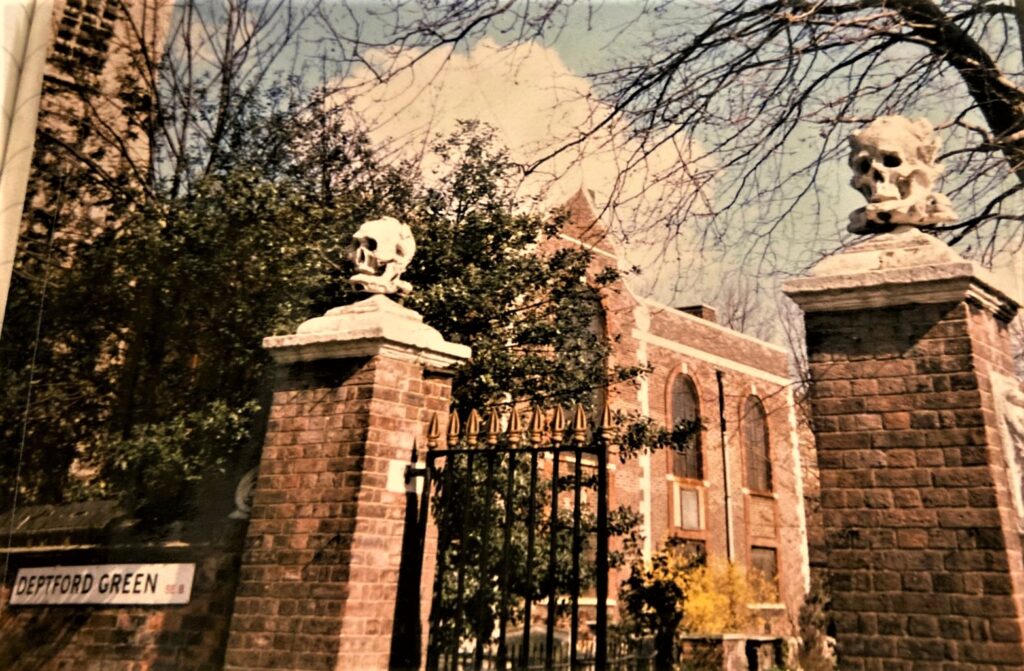
The first time I saw St Nicholas’ Church, it was snowing, it was dark, and I seemed to be the only soul in all S.E.8. The cast-iron gates in the tall, thin eighteenth century brick walls were closed and locked, and there were no lights on inside the round-windowed church or charnel-house. Looming over, blacker than black, were the chunky medieval tower, the oldest building in Deptford, and overhanging yews – and straight in front, two great stone death’s heads surmounting the gateposts, with snow piled up on their laurel-wreathed craniums, the silence and whiteness accentuating the unfathomableness of their eye-sockets.
I seemed to stand in a moralizing Georgian aquatint, the churchly assemblage a cautionary note in the silent townscape, like a backdrop from The Rake’s Progress, or one of Rowlandson’s illustrations for The English Dance of Death – the ‘Horrid’ caperers that burst in upon the frightened Statesman, silence the Virago, wheel the Sot to his long louche home. Like the skeleton grinning madly in the Porter’s Chair, making that unfortunate operative recoil, the skulls of St Nicholas seemed to represent ‘What watchful Care the Portal keeps / A Porter He, who never sleeps.’
A sombre graveyard lies through those gates, most grass killed off by the yews, mud and mean needles giving acidic emphasis to the monuments to chandlers, merchants, shipwrights and John Evelyn’s beloved son, Richard, who died in January 1657 and is remembered searingly in the Diary:
[A]fter six fits of a quartan ague, with which it pleased God to visit him, dies my dear son, Richard, to our inexpressible grief and affliction, five years and three days only, but at that tender age a prodigy for wit and understanding; for beauty of body, a very angel; for endowment of mind, of incredible and rare hopes.
Evelyn probably hoped to see Richard again, because he was a believer in ghostly miracles, as suggested by a scrap of local lore he gave to the Royal Society, which ended up in John Aubrey’s Miscellanies:
…a Note under Mr. Smyth’s Hand [the Curate of Deptford] that in November 1679, as he was sick in bed of an Ague, came to him the Vision of a Master of Arts, with a white Wand in his Hand: And told him, that, if he did lie on his back three Hours, viz. from ten to one, that he should be rid of his Ague. He lay a good while on his back: but at last being weary he turned, and immediately the Ague attacqued him; afterwards, he strictly followed the Direction, and was perfectly cured. He was awake, and it was in the day-time.
Off-duty sailors too sleep under the yews, like Captain George Shelvocke, whose 1726 memoir A Voyage Round the World by Way of the Great South Sea included an incident that inspired one of English literature’s finest poems:
We all observed that we had not had the sight of one fish of any kind since we were come to the southward of the Straits of Le Maire, nor one sea-bird, except a disconsolate black albatross, who accompanied us for several days, hovering about us as if he had lost himself, till Hatley, my second captain … imagining from his colour that it might be some ill-omen, after some fruitless attempts, at length shot the albatross, not doubting, perhaps, that we should have a fair wind after it.
Instead, they experienced six weeks of constant bad weather – but the senseless killing of the bird did at least have one positive consequence decades later. In 1797, William Wordsworth, who had recently been reading Shelvocke’s book, mentioned the incident to Coleridge, who made it the central motif in Rime of the Ancient Mariner.

An even ancienter rime connected to Deptford comes from Chaucer – ‘Sey forth thy tale, and tarie nat the tyme; / Lo, Depeford! And it is half-way pryme.’ The New Cross Road was the main medieval road to Canterbury, sometimes as thronged with pilgrims as it is thronged now with the profane. The ‘depe ford’ was not over the Thames, but the Ravensbourne – supposedly named in reference to the raven flags flown by Sweyn Forkbeard’s fleet, which rampaged up here in 1013 – which flows ten miles up from Bromley to debouch into the more famous river.

Deptford Creek is still a tiny port, where Kentish coasters go in under the lifting bridge (disgusting drivers, delighting me) and come alongside to unload aggregates. The river almost empties at ebb tide, revealing shining mud and shopping trollies perched on by herons. Cranbrook Road, that runs along the Ravensbourne higher up, carries the folk-memory of even less likely avifauna – the cranes that once must have danced and nested among reeds beyond fields. Henry Williamson, author of Tarka the Otter, was a local, and wrote an eco-story about the poor polluted bourne (today’s Ravensbourne is greatly improved), linking a human down-and-out living on its slithery banks, with the last lesioned fish gasping in its filthy flood. Old quay walls host unusual species of crabs and plants, and a little upstream a fig tree, legacies of exotica trafficked through here over years. Earlier incarnations of the bridge were long strategically significant for forces advancing on London, like those of Wat Tyler in 1381, Jack Cade in 1450, and Thomas Wyatt in 1554 – and the scene of a battle on 22 June 1497, when Lord Audley and his Cornish rebels were easily defeated by the Earl of Oxford.

Today’s Deptford has been gentrified – it has a Waitrose, even a Dance Studio – but in the early 1990s it was often cruelly distinctive, surrounded by areas with their own pathologies – Bermondsey, Elephant and Castle, Eltham, Kidbrooke, Millwall, Peckham. It was a little bit of East End that had somehow come south of the Thames. My flat had been built on a road that in the 1930s had been occupied by businesses like Brisbane Laboratories, producers of liquid paraffin and hospital disinfectants, and the Floetta Liquid Soap Co. Ltd., suggesting not only the noxious air quality of those times, but maybe the nature of today’s underlying earth. In summer, drunks lay prostrate in the High Street – I once saw a pitiable woman urinating onto the aghast A2 at midday – and there were high levels of crime. A man pulled a knife on me in a park, luckily just swearing and running away when I – instinctively, stupidly – declined to hand over my wallet. More serious criminals featured frequently in the pages of the South London Press, perpetrators of carried-through muggings, ‘steaming’ attacks on the old slam-door commuter trains (gangs would pass through carriages and demand valuables at blade-point, leaping exultantly out and through the ticket barriers at the next station), and even fatal drive-by shootings. This was an area with some terrible memories – desperate poverty and squalor which long after infused the lurid novels of local boy Edgar Wallace, and which in the 1990s was still in evidence – the 1944 V2 bombing of Woolworth’s opposite Deptford Town Hall, in which 168 were killed – the never-explained 1981 New Cross Fire, in which thirteen teenagers died.
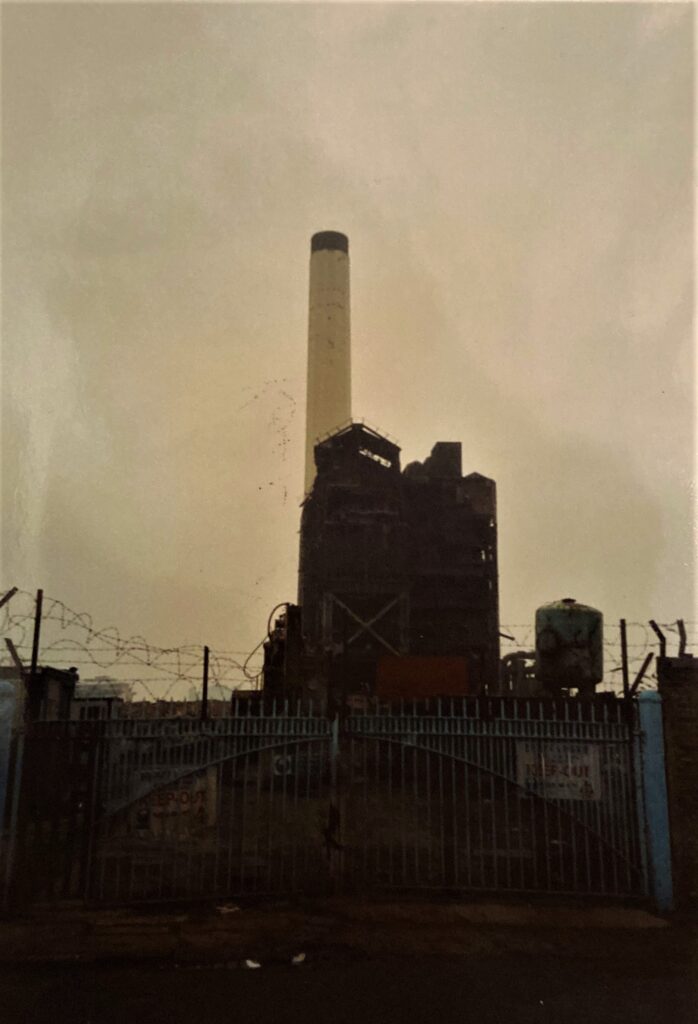
But there were also striking survivals, like the trilby and tie-wearing rag-and-bone man who surreally drove his pony and trap along the frantic A2, stabling his animal down a cobbled lane just behind Deptford High Street. Another cobbled street called The Stowage led to ‘The Light’ – Deptford Power Station, then recently closed, but whose chimney still stood gaunt landmark above SE8 – between scrap yards patrolled by Alsatian dogs that would throw themselves savagely at the corrugated iron fences when they heard you passing. Staff said the basement of No. 2 Turbine-Generator was haunted by those who had died on the gibbets alongside the dry dock.

Not far off were the surviving Georgian gates to the Victualling Yard, with their classical frieze decorated with bucrania (cows’ skulls linked by floral swags), an allusion to Greek and Roman ritual sacrifices. Suitably close was the site of grosser sacrifices, the hugely, horribly busy Foreign Cattle Market of the Victorian and Edwardian periods. In 1907 alone, 184,971 cattle and 49,350 sheep passed through the Market, many to die in the attached slaughterhouses with their notoriously heavy drinking ‘gut girls’ (who could have blamed these women for drinking to forget their days?) There were alleyways where you could get right down to the water’s edge, with cattle (or maybe whale!) bones visible at low tide, amongst dark and viscous sludge. Elements of these animals must have passed across the well-scrubbed surfaces of Wellbeloved’s, a family butcher which had carried on the same business in the same premises since 1828, and only closed in 2021.
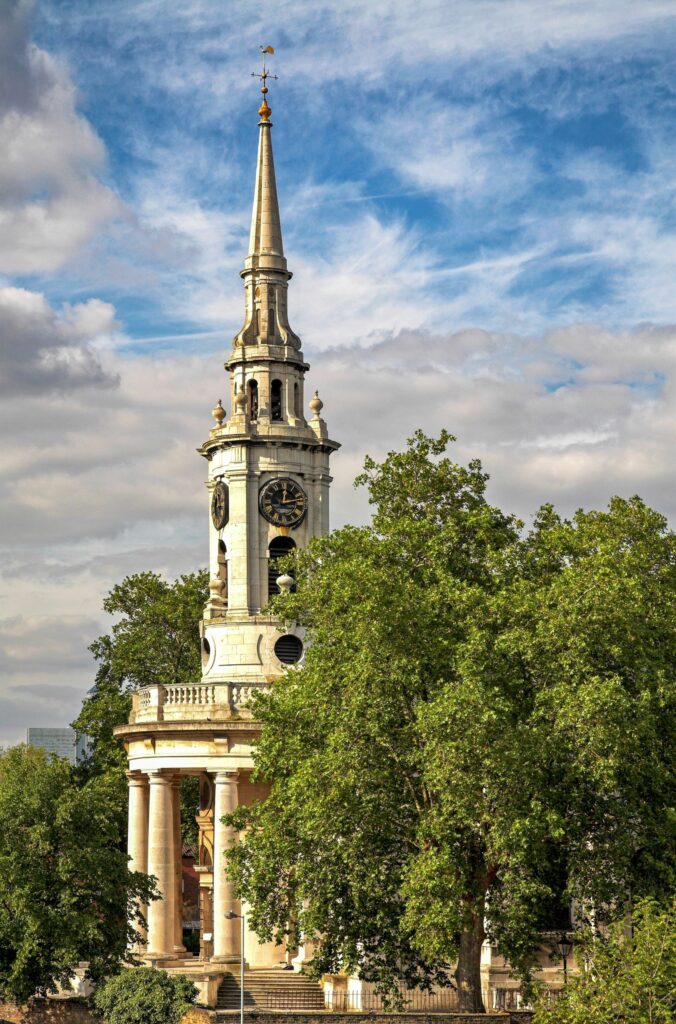
Albury Street had grand Georgian doorcases, plaster cherubim with dimpled knees holding up lead canopies over old sea captains’ houses. Nearby was St Paul’s church, John Betjeman’s ‘pearl in the heart of Deptford,’ an eighteenth century beauty built by Thomas Archer, famous for St John’s, Smith Square. Charles Burney, who was vicar and organist here between 1811 and 1817, was a son of the eponymous and celebrated music historian. He was also brother to James, who travelled with Captain Cook, and Fanny, author of Evelina. He also ran an academy for the sons of local naval officers, so severe that he provoked a rebellion by pupils, who barricaded themselves into the school and beat him with sticks when he burst down the door. In less choleric moments, Burney was a renowned classicist, collector of books and ephemera (who sold his collection to the British Museum for an impressive £13,500), and royal chaplain.
There were some of the oldest surviving shops in London, including a tailor where smirking men made vinegarish comments about the people passing outside as they measured lapels and inside legs, in a 1650s cubbyhole made even darker by racks of tweeds, and 1970s photos of hirsute men wearing flared trousers made of alarming cloths. There was even the last smithy in SE8, where I had burglar bars made by a hatchet-faced and taciturn man in a tiny forge smelling of hand-rolled cigarettes and hot steel. This tiny iron underworld felt at one with all the other outdated crucibles of identity, from shipbuilding and milling to imperial imports and industrial oils – all of them contrasting with, yet also oddly complementing, the elegant churches and stories of Tudor, Stuart and Georgian derring-do.
Outside grand Victorian villas on Lewisham Way stands Deptford’s 1930s war memorial, a stele with a stone flame on top, and a staring-down soldier, his rifle pointing to the ground – an irrelevantly outdated symbol, yet at whose feet every year the red poppies are renewed. All things combine, come together as symbols of a suburb past and present – a place that has changed, is always changing, but where even now old memory has not been entirely erased.
DEREK TURNER is the editor of The Brazen Head, as well as a novelist (A Modern Journey, Displacement, and Sea Changes) and reviewer. His first non-fiction book, Edge of England: Landfall in Lincolnshire, was published June 2022. Some of his writing may be found at www.derek-turner.com He is also on Twitter – @derekturner1964